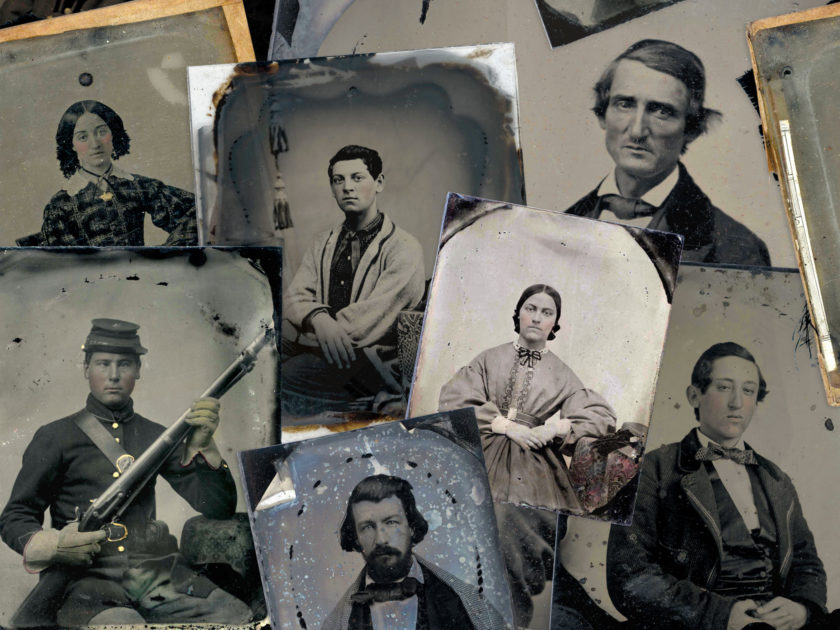Included among the millions of artifacts in the collections of the Adams County Historical Society are these hard plate portraits of individuals connected to Gettysburg, Pa. Most were residents whose homes became part of a sprawling battlefield, a hospital following the end of the three-day fight, and, later, hallowed ground visited by uncounted Americans seeking to commemorate and understand the bloody, brutal conflict that tore the country apart. The shared experiences of the men and women pictured here are representative of all citizens and noncombatants thrust into the center of conflict.
ACHS Historian Tim Smith selected these images, consulted on the captions, and provided approximate locations of where those pictured lived in Gettysburg—modern designations as street addresses did not exist in 1863.
 Sixth-plate ambrotype by an unidentified photographer.
Sixth-plate ambrotype by an unidentified photographer.
In The Wilderness
Had he not joined the army, Benjamin Keller Culp might have been in his hometown of Gettysburg during the battle. But Keller, as he was known to family and comrades, opted to enlist in Company B of the 138th Pennsylvania Infantry during the summer of 1862. He managed to escape serious harm until the May 1864 Battle of the Wilderness, where 156 members of the regiment, including Keller, fell into enemy hands and landed in Andersonville Prison, where he died in December 1864. Keller was 20 years old and unmarried.
 Sixth-plate ambrotype by an unidentified photographer.
Sixth-plate ambrotype by an unidentified photographer.
 Sixth-plate ambrotype by an unidentified photographer.
Sixth-plate ambrotype by an unidentified photographer.
First Blood
Schoolteacher Elizabeth Salome ‘Sallie’ Myers and her family lived on the first block of West High Street (currently 55 West High) when the war came to town. Her first glimpse of blood rattled her—a horse was led by with a head injury during the first day’s fight. Then came badly wounded Union soldiers, and 21-year-old Sallie stepped up and nursed many of the injured. One man she could not save, Sgt. Alexander Stewart of the 149th Pennsylvania Infantry, had suffered mortal wounds to his lungs and spine. The following year, she met Alexander’s brother, Henry, who had served in the 149th until an accidental axe wound ended his service a few months before the battle. They married, but the union was short-lived. Henry died in 1868, reportedly from his wound. Sallie, a widow with a young son, never remarried. Active in the National Association of Army Nurses, she died in 1922 at age 79.
 Sixth-plate ambrotype by an unidentified photographer.
Sixth-plate ambrotype by an unidentified photographer.
In the Home Brigade
Craig Buchanan Shields’ gravesite is located in Gettysburg’s Evergreen Cemetery, and engraved with his name and those of his wife, Mary, and two children. Shields, an Adams County native, moved from York Springs to Gettysburg in the 1850s, and established himself as a coach painter. When the war came, he enlisted as a private in Company C of the 1st Potomac Home Brigade Cavalry, organized in Frederick, Md., in late 1861. The unit was also known as Cole’s Cavalry for its colonel, Henry A. Cole. Shields reportedly served two years and two months, during which Cole’s troopers participated in numerous engagements—but not Gettysburg. Shields survived his service and the war. He returned to Gettysburg, married, and eventually became janitor of the local high school. He died in 1916 at age 72.
 Sixth-plate ambrotype by an unidentified photographer.
Sixth-plate ambrotype by an unidentified photographer.
Battle Baby
Union-loyal citizens rejoiced on July 4, 1863, as Gen. Robert E. Lee and his battered Army of Northern Virginia withdrew from Gettysburg after three days of brutal fighting resulted in 51,000 casualties.
The humanitarian effort to help the injured and sick and bury the dead was just getting underway. Meanwhile in a home at 141 York Street, a son was born to Jeremiah Culp, a local cabinetmaker and undertaker, and his wife, Rebecca. They named the child Jeremiah Meade Culp in honor of the Union general and Pennsylvanian overall command of Union forces. Sadly, the infant died five weeks later. Two years later they had another son and named him Harvey Reynolds Culp, in honor of the respected Union general that fell in the beginning of the fight. Harvey lived until 1951. Jeremiah passed in 1887 and Rebecca joined him in death three years later. The Culp house still stands at 141 York Street.
 Sixth-plate ambrotype by an unidentified photographer.
Sixth-plate ambrotype by an unidentified photographer.
Tending Wounded at the Courthouse
The Adams County Courthouse, completed only a few years before the war, became a large emergency room during the battle. Among the local women who assisted the casualties was Mary Ann Culp Blessing. The 27-year-old daughter of Daniel and Elizabeth Culp, she had married confectioner George W.E. Blessing in 1860. She and George lived in her parents’ home on Baltimore Street just south of the Courthouse.
The battle resulted in a pair of personal tragedies. Her first cousin John Wesley Culp, of the Confederate 2nd Virginia Infantry, was killed during the fighting, and her younger brother, James M. Culp, was killed after an artillery shell picked up after the battle exploded. She suffered two other deaths: an infant son in 1862 and husband George in 1864.
Mary Ann remained in Gettysburg for the rest of her life. She lived in the family home until her death in 1918 at age 82.
 Sixth-plate ambrotype by an unidentified photographer.
Sixth-plate ambrotype by an unidentified photographer.
 Sixth-plate ambrotype by an unidentified photographer.
Sixth-plate ambrotype by an unidentified photographer.
Three Generations
Three generations of the Myers family are represented in these two portraits. All were present during the battle. They lived together in Warren Block, an apartment-type building at the current address of 215 Chambersburg Street. Their next-door neighbor, Sarah Broadhead, authored the acclaimed The Diary of a Lady of Gettysburg, Pennsylvania from June 15 to July 15, 1863.
Maryland-born George Gilbert Myers, the patriarch of the family, married Elizabeth Sheads in Gettysburg in 1835 and had six children. Two of them died young: An infant daughter, Amanda, and Pvt. David Gilbert Myers of the 87th Pennsylvania Infantry, who fell into enemy hands during the Battle of the Wilderness in May 1864 and died four months later at Andersonville.
The elder Myers is pictured here with his grandson, Gilbert, who was just a few weeks shy of his fifth birthday when the war came to Gettysburg. He lived until 1930.
Young Gilbert’s father, George W. Myers, is also shown. A year later, he enlisted as a private in Company G of the 209th Pennsylvania Infantry. Wounded along the front lines of Petersburg, he survived his injury and mustered out in May 1865. A painter by trade, he went on to become a Gettysburg police officer, and rose to chief of the department. He died in 1908 at age 71.
 Sixth-plate daguerreotype by an unidentified photographer.
Sixth-plate daguerreotype by an unidentified photographer.
Sarah’s War
Had civil war not ravaged the country, Sarah Sheads might have enjoyed life with her husband, Isaac, and two children under 13, Charles and Ida. Born Sarah Maria Pelton in Connecticut in 1824, she married Isaac, eight years her senior, in the 1840s. Records suggest that Isaac had moved to New Haven, Conn., to work in the textile mills. They relocated to Isaac’s hometown with young Charles in tow in the early 1850s, perhaps to take advantage of his large extended family for support.
In the fall of 1861, Isaac, now 45, enlisted as a private in the 87th Pennsylvania Infantry. The regiment participated in numerous engagements during its 3-year-enlistment, though Gettysburg was not among them. Isaac did not live to see peace restored to the nation, having suffered a mortal wound at the Battle of Cold Harbor in 1864.
Widowed Sarah did not remarry. She lived until 1885, dying at age 60. Her son Charles became a battlefield guide in Gettysburg.
 Sixth-plate ambrotype by an unidentified photographer.
Sixth-plate ambrotype by an unidentified photographer.
A Brooklyn Boy Visits Gettysburg
A note with the image indicates this is “Jimmie Rankin, a boy from Brooklyn,” who spent a winter in Gettysburg under circumstances currently unknown. He is James D. Rankin, who joined Company H of the 14th New York Militia Infantry in April 1861. A younger brother, William, enlisted with him. The regiment mustered for federal service as the Empire State’s 84th Infantry. A disability cut short Rankin’s enlistment in January 1863. By this time, the 84th had participated in the First and Second Battles of Bull Run, South Mountain, Antietam and Fredericksburg. Rankin returned to Brooklyn and became active in his local Grand Army of the Republic post named for his brother, a regimental favorite killed in May 1864 at the Battle of Laurel Hill, Va. Rankin died in 1916 of consumption and was buried in Green-Wood Cemetery.
 Sixth-plate ambrotype by an unidentified photographer.
Sixth-plate ambrotype by an unidentified photographer.
Tennessee Transplant
William E. Maurey holds the distinction of being connected to three places synonymous with the Civil War. The first, Gettysburg, was his hometown. But he did not live there at the time of the battle. Maurey had relocated at some point before 1860 to Robertson, Tenn., a community about 30 miles north of Nashville. In late 1861, he joined the Confederate army as a private in his adopted state’s 49th Infantry, and rose in rank to sergeant of his Company C. The second place, Fort Donelson, is where he fell into enemy hands and spent nine months as a prisoner of war at Chicago’s Camp Douglas. The final location, Franklin, is the Tennessee battlefield where he died on Nov. 30, 1864.
LEARN MORE about Military Images, America’s only magazine dedicated to showcasing, interpreting and preserving Civil War portrait photography.
VISIT OUR STORE to subscribe, renew a subscription, and more.


1 thought on “They Knew Gettysburg Before the Battle”
Comments are closed.